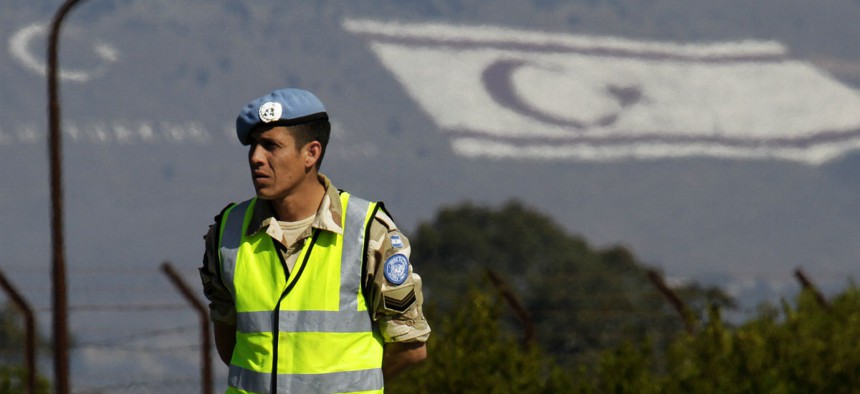UN Peacekeeping Needs Major Technological Update

An Argentinean UN peacekeeper stands guard in northern Cyprus. Petros Karadjias/AP
For peacekeepers to be effective, they need up-to-date tech at their disposal.
UN peacekeeping troops used to say that if villagers wanted to alert troops that they were in danger, they had to “bang their pots and pans together.” The saying shows how outdated UN technology used to be. Even now, UN missions do not use their technology to its full potential, according to a recent report.
Written by the Expert Panel on Technology and Innovation in UN Peacekeeping, referred to as the Expert Panel, it proposes that peacekeepers begin to incorporate new technologies into their peacekeeping missions. The recommendations have the support of the UN’s peacekeeping department. Yet, which technologies to incorporate, as well as their hefty costs, complicate the initiative.
UN troops go on missions without technology that most militaries, law-enforcement agencies and international-aid organizations take for granted. Besides facing outdated accommodations and transportation, UN troops have little to no access to radio, telephone, or data communications. Even smartphones and tablets are not in the peacekeepers’ kits.
Forces on the ground do not use crucial surveillance and monitoring technologies, such as video-enabled observation posts or ground-surveillance radar monitors, to keep staff-residential and refugee camps safe. Geographic information system-operated devises (GIS) that are used to gather topographical data, or aircrafts and drones, which can fly out and capture aerial visuals, are either missing from missions or have not been developed to the point of feasible employment. If UN troops are forced to leave an area in a hurry, resources for fast redeployment are not up to the task.
Among the needed technologies mentioned in the report are unmanned autonomous vehicles, or drones, reconnaissance and surveillance suites, and the means for real-time visibility into mission areas. The report also recommends making improvements in areas such as surveillance, command and control, and monitoring, all of which allude to the need for more military-style equipment.
“Why shouldn’t the UN enjoy the same technology as those used by countries’ military forces and police?” the Expert Panel’s chair, Jane Lute, tells Quartz. She added that it is up the UN to ensure that the principles of transparency and disclosure apply.
Some technologies may raise red flags with the UN, nonetheless. The organization, for example, has been hesitant to authorize the use of drones—a tool that the report’s authors argue is becoming is “ever more widely available for every conceivable application in the commercial, law-enforcement, military and social spheres.”
Many of the UN’s member states such as Pakistan, which has been subject to controversial drone strikes piloted by the US military in recent years, also vehemently oppose use of drones. Yet in that regard, the Expert Panel calls on member states to embrace the technology and to shatter ideas that drones are “particularly non-transparent and intrusive technology.”
“It feels like more of an excuse if we are not using this technology,” Lute notes, making the case for a logic that the UN has been resisting: Why not use advanced technology that is already available?
Bearing the costs
Dirk Druet who works at United Nations Departments of Peacekeeping Operations and Field Suppor, tells Quartz that that the undersecretaries of the departments of Peacekeeping and Field Support have endorsed all of the Expert Panel’s recommendations and the peacekeeping department’s offices are currently in the process of implementing them. (Druet coordinates the taskforce that is working on the implementations.)
Besides taking “a new and strategic approach to technology,” the report is challenging the UN to take on more innovative technologies. “It’s not just a set of tools helping you to do tasks, but it fundamentally shifts the way we do business,” Druet adds.
Professor Walter Dorn at Royal Military College of Canada has advised the UN many times on technological innovations. He explained to Quartz how the UN could adopt new technologies that are easy to implement, some of which include motion-activated illuminators, night-vision goggles, acoustic sensors, and tracking, communication, and GPS devices.
He added that to overcome connectivity issues troops face on the field, the UN could expand the range of cellphone receptivity, or subsidize certain areas to receive low-cost cell phone reception.
Cost will depend on what technologies the UN decides to invest in. Dorn said it could range from a few million US dollars to several billion—possibly surpassing the peacekeeping department’s entire annual budget for this year, which is just $8.5 billion.
Based on budget performance reports of UN peacekeeping missions, 14 out of 16 missions have spent over $50 million dollars on information technology between 2013 and 2014 while the overall budget for that year totaled roughly $7.8 billion dollars. Though that is indeed a large sum, it remains insufficient.
Druet says his department will soon be making budgetary recommendations to the UN’s member states, which generally share these costs. Druet said in addition, the countries sending troops on a given mission also cover the technologies deployed by their own battalions or units.
Moreover, Druet hopes that when the peacekeeping summit takes place during the 70th session of the UN General Assembly, technology will part of its goals.
Although US president Barak Obama is expected to ask leaders to boost peacekeeping efforts, this will most likely translate as committing more troops to peacekeeping. “For the summit, we have issued a call that as our operating environment has become more complex in recent years, and have made a request for some of the more sophisticated capabilities and technologies,” he said.
Another purpose of incorporating new technology would be to raise the UN’s accountability. With reemerging news of child rape committed by UN peacekeeping forces in the Central African Republic, following a series of cases that were covered up then reported last year, the peacekeeping department is falling under immense scrutiny.
“We know that some peacekeepers misbehave,” Dorn says. “Technology can be used to get evidence of [violations]. Body cameras can record whatever is happening, and those cannot be turned off.”
NEXT STORY: EIS RFP might spill into October






